Nintendo DSi Handheld Games Console Review
Nintendo DSi Handheld Games Console
The DS Lite was the perfect evolution of the original DS, but does the DSi do enough to justify its price?
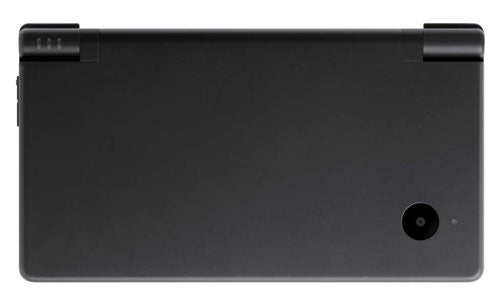
Verdict
Key Specifications
- Review Price: £144.97
Four years after the launch of Nintendo’s DS, it’s hard to remember that, at the time, its success felt anything but inevitable. While tech sites and gadget mags were drooling all over Sony’s PSP (us included), the DS has us mystified. What was the point of the dual screens? Why the touch-screen and not a more conventional analogue control? Was it really wise to launch a system so behind the PSP in 3D horsepower? Yet now it seems clear that Nintendo made all the right choices, eventually matching its innovative hardware with equally innovative software that would draw in whole new audiences to video gaming. I can’t really blame ourselves or anyone else for underestimating the DS. Back in 2005, without the software to show off Nintendo’s new direction, it was impossible to see what was to come. Nintendo was thinking out of the box, and we were still stuck inside it.
I’m reminded of this now while looking at the brand-new DSi. My immediate verdict is that Nintendo’s third-generation DSi is too expensive, too gimmicky and too limited an upgrade over the deeply lovable DS Lite to be worth buying, yet my gut feeling is that I might be making the same mistake I did with the DS. To explain why, let’s look at the new model in more detail.
The first surprise is that, physically, the DSi doesn’t stray too far from the DS Lite. It’s a few millimetres wider and longer and very slightly thinner. Open it up, and the screens are a quarter-inch larger. The volume control has been moved from a slider on the front to a rocket on the left-hand-side and the power slider on the right-side has now become a button to the left of the bottom screen beneath the D-Pad. The L and R shoulder buttons are slightly smaller. The gloss finish of the DS Lite has been swapped for a matt surface, and the speaker grilles on either side of the top screen have been replaced by two tiny apertures. The DS logo on the lid has disappeared. Nintendo has talked about the DSi as an evolution of the DS Lite, and you can see that everywhere you look and everywhere you touch.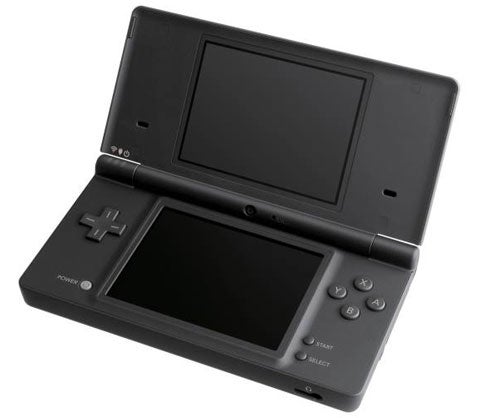
The major changes are three additions and one subtraction. The first you’ll notice is the arrival of a lens pointing out of the top lid, indicating the presence of one of the DSi’s two VGA cameras. You’ll find the other when you open up the clamshell, neatly tucked away in the hinge. On the right hand side, meanwhile, you’ll now find an SD memory card slot that’s also SDHC compliant. Finally, the GBA slot has made its way to the knacker’s yard; clearly Nintendo is now confident that compatibility with its last-generation of hardware is no longer an issue worth bothering with, and hammered the last nail in the coffin of the classic Game Boy line.
The DS Lite’s screens were a huge improvement on the wishy-washy displays of the original DS, and the DSi’s screens are even better, the additional size and marginally improved brightness making this the most comfortable DS for long-term use yet. There’s no difference in terms of resolution – we’re still talking 256 x 192 pixels – but colours seem ever-so-slightly richer and clarity is superb. It’s a pleasure digging out old favourites like Zelda: The Phantom Hourglass or Professor Layton and the Mysterious Village just to appreciate how good they look, and the new screens certainly make the teeny-tiny graphics of Rockstar’s phenomenal GTA: Chinatown Wars that little bit easier to make sense of.
There are other hardware changes under the bonnet. As always, Nintendo is cagey about the DSi’s exact specification, but the old 67MHz ARM 9 and 33MHz ARM 7 CPUs have been upgraded to a newer ARM 9 or ARM 11 processor running at – it’s believed – 266MHz. RAM, meanwhile, has gone up from 4 to 16MB. On top of this, the unit has 156MB of built-in flash memory.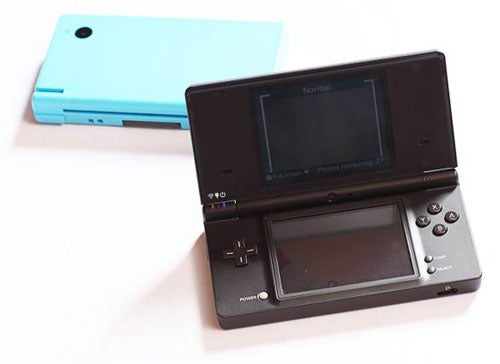
Why such substantial upgrades for what is apparently an evolutionary product, not a DS sequel? Well, for the moment at least it’s not for the expected reason; to make more advanced or graphically intensive games. Nintendo isn’t launching the DSi with a range of DSi-specific games to show off the hardware, though there are plans to release DS-compatible games with additional DSi features. Instead, the impetus behind the hardware changes seems more to be about image and audio manipulation, Internet applications and the applications you’ll be able to download from the all-new DSi store.
You’ll find all these features upfront in the new DSi interface, which takes its look and feel directly from the Wii’s GUI. The home page has a series of horizontally scrolling boxes, featuring a settings menu, the currently installed cartridge, the new DSi camera and sound apps, the DSi Shop, Download play and our old friend, Picto-Chat, along with a huge series of empty boxes sitting there ready to accept other applications at a later date.
The camera app will be most people’s first port of call. It’s very nicely done and targeted directly at the family audience, allowing you to switch between the built-in memory or the currently inserted SD card, then take images using either camera and save them into albums organised by calendar. Image quality is exactly what you’d expect; colours are mostly fine, but the low resolution is a limiting factor and noise is an issue in dark or even gloomy conditions. However, that’s not really the point – it’s unlikely that you’ll use the DSi as your main digital camera, and most of us are more likely to use one built into our current choice of phone. 
What is the point is fun. The camera app includes a range of ‘lenses’ which can be used to warp or colour faces or objects in the image, scrawl over the picture, super-impose sunglasses or a moustache, plus a selection of other effects. The clever bit is that you can apply these effects in real-time, both while you’re capturing the image and once it’s in the album after capture. It’s quick, it’s entertaining, and while it’s nothing you couldn’t do with a PC, appropriate software and a digital camera or Webcam, there’s something so immediate about it on the DSi that you can’t help playing around with it. Images stored on the SD card can, of course, be taken off the DSi and onto a PC or Mac.
There’s a similar tale with the sound app, where you can record and then play with audio using the DSi’s built-in microphone or work on tracks stored on an inserted SD card. It is annoying and slightly odd that Nintendo has chosen AAC over MP3 as its sole supported file format, but again this isn’t a fatal weakness for the reason that you’re unlikely to make the DSi your sole MP3 player. Instead, you’re encouraged just to mess around, playing along with the track in real-time to add cat or dog noises to the beats, remove the vocal tracks or alter the tempo and pitch. Record a sound, and you can perform some of the same tricks. This isn’t serious stuff, but it’s not meant to be. It’s quick. It’s silly. It’s fun.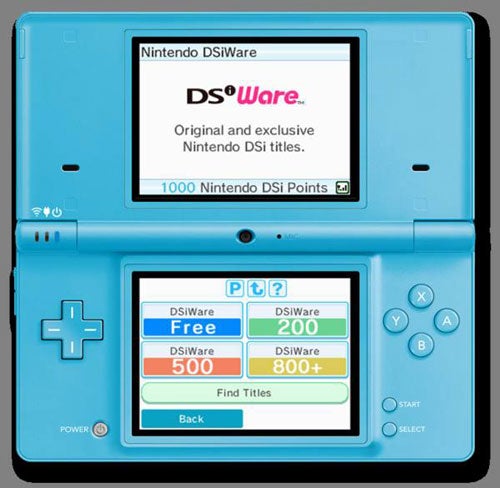
Of course, it’s also slightly gimmicky fun, of the sort that you and/or your friends/offspring will probably tire of within a week or so of having your DSi. Given the £150 asking price, that’s not really enough to recommend splashing out on the DSi in the first place. This is where things get tricky. For one thing, it remains to be seen whether Nintendo and the big third-party publishers can create games that use the cameras as part of an innovative control system or a genuinely entertaining feature. Sure, it’s a long shot, but then we said similar things about the touchscreen controls of the DS. For another thing, a lot rests on the software that flows to the DSi in the shape of DSi Ware on the DSi store.
Here Nintendo is both taking the concept of WiiWare to a handheld format and taking a leaf from Apple’s book. There is a lot of talk about the DSi shop providing smaller apps like calculators, calendars, to-do lists, map applications and translation apps, all of which will be familiar to owners of the iPhone or iPod touch (not to mention the Blackberry, Symbian and Android equivalents). The idea is that DSi owners will be only too pleased to fill up their SD cards and those empty boxes on the home screen with simple, cheap, useful apps. However, it’s also likely that the DSi shop will be the major outlet for DSi-specific games rather than the usual retail points.
The European store has only just opened, and at the moment there isn’t really a lot to get excited about. The free Web browser, based on Opera, is surprisingly usable and functional, but game-wise we’re limited to a range of very, very simple puzzle and arcade games and one, sole ‘keystone’ release, WarioWare Snapped. The latter, which features camera controls similar to a cut-down EyeToy game, is an interesting experiment, but the controls aren’t particularly effective and the impression is of a game that’s high on novelty value, but low on long-term appeal. This isn’t a disaster given that all these games are cheap (even WarioWare Snapped is 500 Wii points, or less than £5), but at the moment it’s difficult to get a real feel for the DSi experience, as Nintendo envisages it.
That’s why it’s hard to come up with a definitive verdict on the DSi at this stage. At this exact moment, it’s hard to justify upgrading from a DS to a DSi or buying a DSi instead of a DS just to mess around with some low-resolution images, particularly given the £50 difference in price. It’s also unlikely that Nintendo will move its biggest hitters – Brain Training, Mario, Zelda – to the DSi and risk alienating the huge existing DS userbase. DSi owners will get enhanced versions of the DS games, but whether these enhancements will be major or minor it’s impossible to say at this stage of the game. Finally, it’s worth remembering that the £150 price point puts it in contention with Apple’s iPod touch. While the DS still has the better games overall, the touch/iPhone platform now has a handful of excellent titles, a wider range of alternative apps, better audio and video features plus support from industry heavyweights like Electronic Arts and Konami. This just can’t be ignored.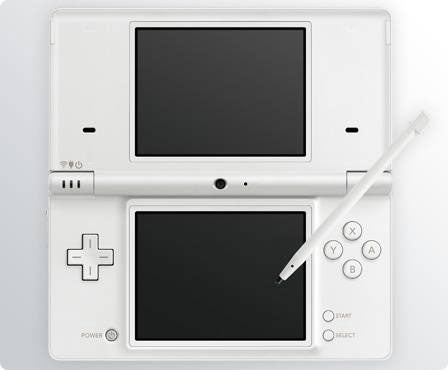
Given these things, it’s tempting to write off the DSi. However, in six months time Nintendo might just release something that makes the DSi feel utterly essential, and me feel silly for ever doubting it. The new Zelda or a new Mario game might appear with features that will make the DS version feel like half the experience, or something of the quality of LostWinds or World of Goo might appear in the DSi shop. Personally, I’d hold off for now until that happens, but if you want a new handheld and feel like taking a small risk, then the DSi is a very interesting little beast indeed.
”’Verdict”’
Right now, the DSi doesn’t feel like an essential upgrade over the existing DS Lite, but with the cameras, the extra CPU horsepower and the DSi Shop, there’s potential for that situation to change. Don’t write it off.

